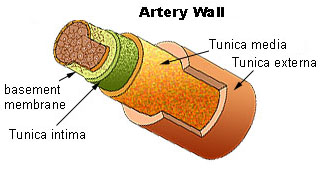artery

An artery is a major blood vessel that carries oxygenated blood from the heart to the tissues and forms part of the circulatory system. All arteries except the pulmonary artery carry oxygenated blood. Pulmonary arteries transport blood that has a low oxygen content from the right ventricle to the lungs. Systemic arteries transport oxygenated blood from the left ventricle to the body tissues. Blood is pumped from the ventricles into large elastic arteries that branch repeatedly into smaller and smaller arteries until the branching results in microscopic arteries called arterioles. The arterioles play a key role in regulating blood flow into the tissue capillaries. About 10 percent of the total blood volume is in the systemic arterial system at any given time.
The wall of an artery consists of three layers. The innermost layer, the tunica intima (also called tunica interna), is simple squamous endothelium surrounded by a connective tissue basement membrane with elastic fibers. The middle layer, the tunica media, is primarily smooth muscle and is usually the thickest layer. It not only provides support for the vessel but also changes vessel diameter to regulate blood flow and blood pressure. The outermost layer, which attaches the vessel to the surrounding tissue, is the tunica externa or tunica adventitia. This layer is connective tissue with varying amounts of elastic and collagenous fibers. The connective tissue in this layer is quite dense where it is adjacent to the tunic media, but it changes to loose connective tissue near the periphery of the vessel.
Major arteries of the body of humans and most other vertebrates include:
Fish have only one arterial system, which leads from the heart via the gills to the body.
Arterial embolization is the blocking of an artery by a clot of foreign material. This can be done as treatment to block the flow of blood to a tumor.
An arteriogram is an X-ray of arteries. The person receives an injection of a dye that outlines the vessels on the X-ray. arteriography is the procedure used to X-ray arteries.


